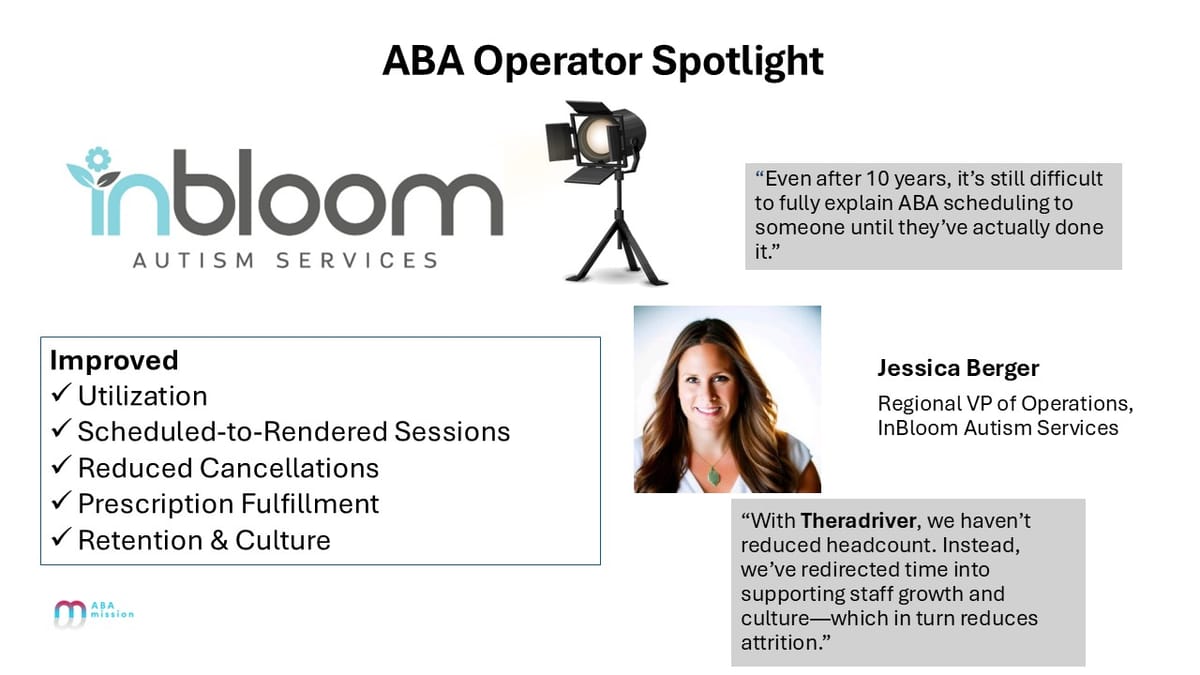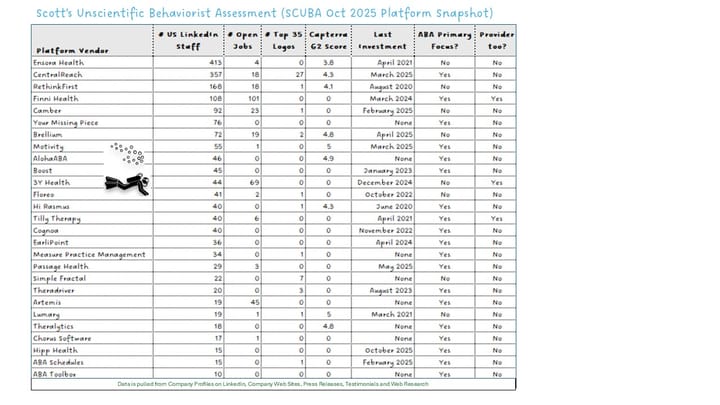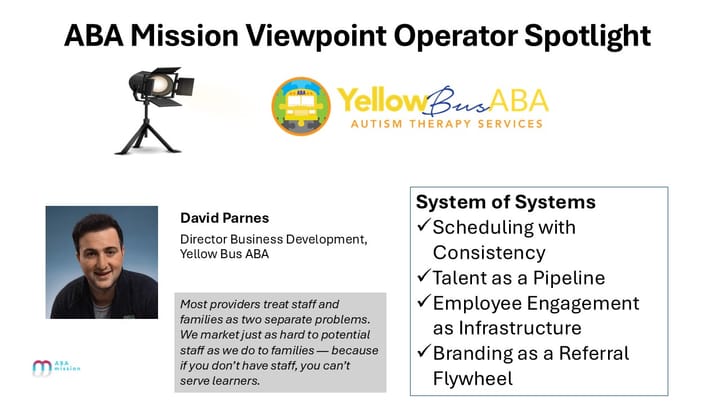Operator Spotlight: How InBloom Reframed Scheduling as a Strategic Advantage

Utilization, Retention, and Culture Gains from Smarter Operations
A Shift in Perspective
I’ve long believed that large ABA providers needed dedicated full-time schedulers to survive the complexity of matching RBTs, families, and prescriptions. But my conversation with Jessica Berger, Regional VP of Operations at InBloom Autism Services, changed that thinking.
For providers that are primarily clinic-based, scheduling doesn’t have to be a full-time role. With the right tool and operational leadership, it can be distributed across clinic directors, BCBAs, and lead RBTs—and even become a culture driver rather than just an administrative burden.
From Clinician to Operator
Jessica’s path into operations wasn’t typical. She started as an RBT, later took on scheduling and intake responsibilities, and discovered she had a knack for building processes that worked. That progression—from frontline clinician to operations leader—remains rare in ABA.
It also turned out to be an advantage. Unlike many operators who arrive from outside healthcare, Jessica understood both the day-to-day reality of delivering therapy and the operational demands of scaling a large organization. That dual perspective helped her see scheduling not just as an administrative task, but as a strategic bottleneck that needed to be solved.
This grounding in both clinical and operational worlds shaped how InBloom approached the challenge: implementing a system that reduced scheduling burden while freeing up leaders to focus on staff development and client outcomes.
InBloom’s Strategic Model
InBloom operates 25+ clinics and growing, specializing in early intervention, clinic-based services.
While the organization has scale, leadership encourages each clinic to develop its own identity and culture within a shared operational framework. The emphasis on natural environment training (NET) and play-based learning makes InBloom’s centers feel less like sterile therapy environments and more like spaces where children can thrive socially and developmentally.
But even with this strong clinic-first model, one challenge remained stubbornly difficult: scheduling.
The Scheduling Challenge
Before adopting a new tool, scheduling at InBloom looked like this:
- Clinic directors were spending 30+ hours per week on scheduling.
- Schedules were first built in Excel, then re-entered manually into CentralReach.
- Last-minute cancellations created cascading domino effects that were almost impossible to manage at scale.
As Jessica put it:
“Even after 10 years, it’s still difficult to fully explain ABA scheduling to someone until they’ve actually done it.”
The burden was pulling leaders away from the mentorship and culture-building that staff needed most.
The Operational Shift: Adopting TheraDriver
To address that pain point, InBloom implemented TheraDriver. The impact was visible almost immediately:
- Scheduling time cut in half within two weeks, even while staff were still learning the system.
- Constraints like female-only, seizure protocols, and backup RBT pools were easily built in.
- Automatic schedule regeneration managed the “domino effect” of cancellations better than Excel ever could.
Critically, integration with CentralReach eliminated double entry. All recurring schedules are created and maintained in TheraDriver. Any changes—new sessions, swaps, cancellations—flow downstream into CR automatically. Clinic staff can work in the tool they find usable, while CR remains the system of record.
Measurable Outcomes
The results speak for themselves:
- Utilization: InBloom has averaged over 80% across the company over the past six months.
- Schedule-to-Rendered Sessions: Planned sessions converted to billable net sessions have increased to 97%.
- Cancellation Reduction: Earlier pattern detection enables faster intervention with parents.
- Prescription Fulfillment: Smarter scheduling has pushed families closer to their medically recommended hours.
- Retention & Culture: Freed from scheduling drudgery, clinic directors spend more time on mentorship, career pathing, and staff check-ins. RBTs have better work-life balance and BCBAs now use the system directly to plan supervision and parent training.
And importantly:
“With Theradriver, we haven’t reduced headcount. Instead, we’ve redirected time into supporting staff growth and culture—which in turn reduces attrition.”
Looking Ahead
Jessica and her team are now working on future-state forecasting—quarterly “sandbox” scheduling that allows better long-range planning of staff and client needs.
They’re also expanding KPI visibility: cancellations by source (parent vs. clinic), prescription fulfillment rates, and other metrics that connect scheduling directly to clinical and financial outcomes.
Closing Reflection
What stands out in this story isn’t just the measurable gains. It’s the way scheduling has been reframed: from a time sink and source of burnout to a strategic lever for culture and retention.
And it’s no coincidence that this transformation is being led by someone who started on the clinical side. Jessica’s journey from RBT to operations leader underscores the value of operators who understand ABA from the ground up.
For providers that are predominantly clinic-based, this story suggests a different lesson: you may not need a dedicated scheduling function at all. With the right leadership and the right tools, scheduling can shift from being a standalone burden to a shared responsibility that strengthens utilization, culture, and staff satisfaction.



